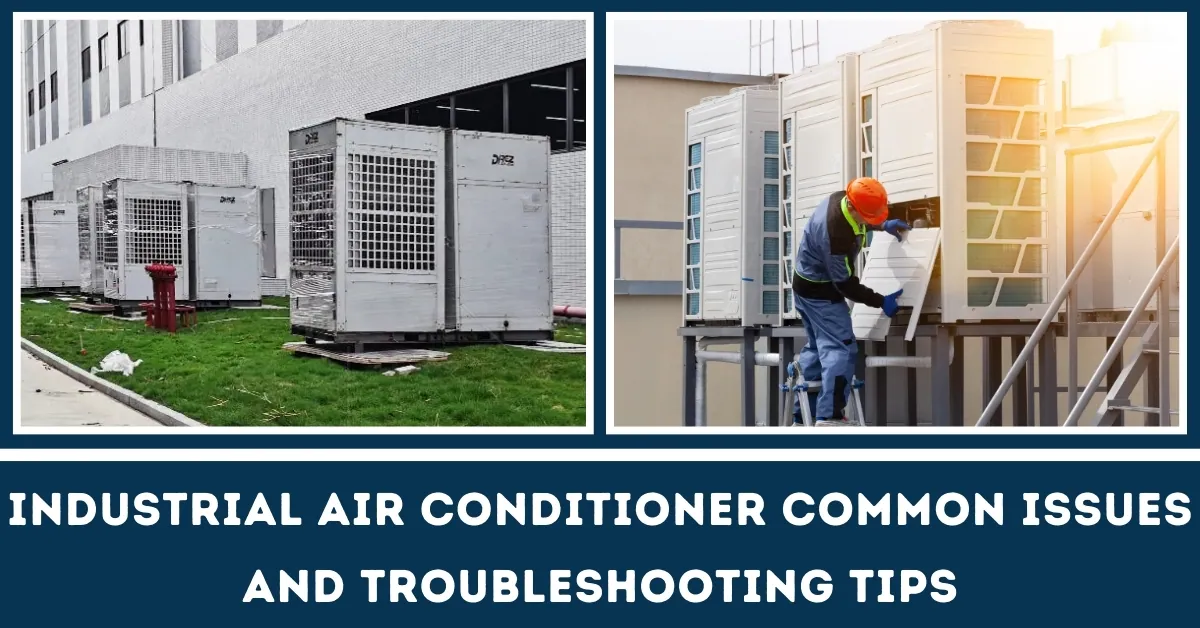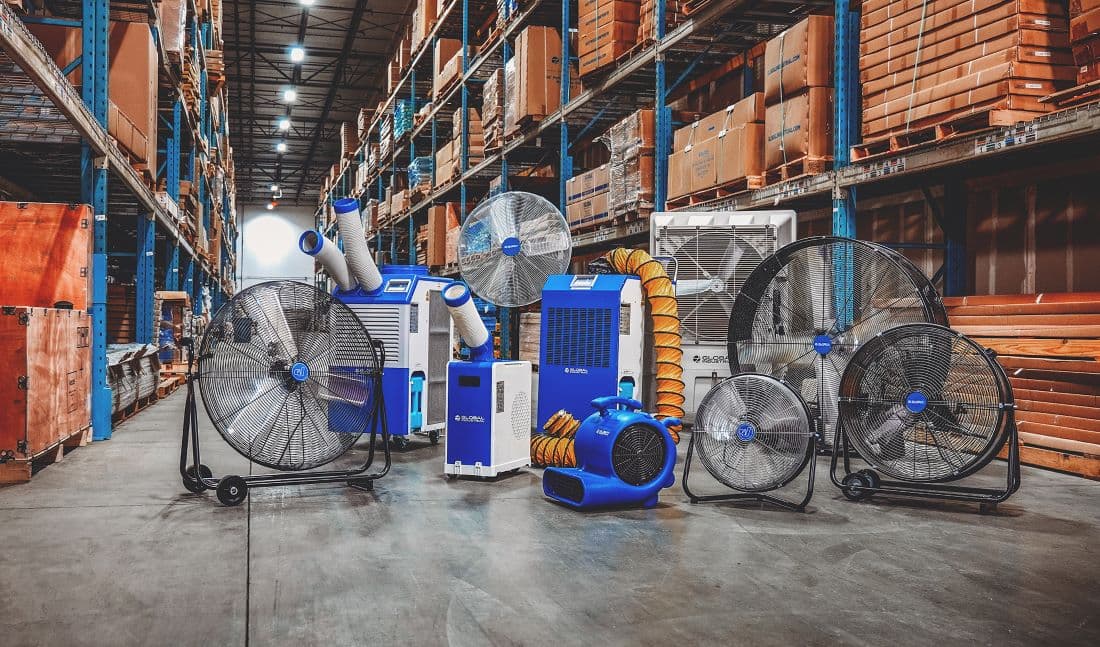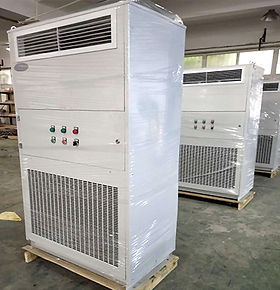Have you ever wondered how huge factories and warehouses stay cool, even when machines are working non-stop and temperatures soar? That’s where industrial air conditioning comes in.
It’s not just about comfort—it’s about keeping your equipment safe, your workers productive, and your business running smoothly. You’ll discover exactly what industrial air conditioning is, why it matters to your operations, and how it can make a big difference in your workplace.
Keep reading to unlock the secrets behind these powerful cooling systems and find out how they could benefit you.
Basics Of Industrial Air Conditioning
Industrial air conditioning keeps large spaces cool and comfortable. It controls temperature, humidity, and air quality in factories, warehouses, and offices. These systems are powerful and designed to work continuously in tough environments. Understanding the basics helps in choosing the right system and maintaining it well.
Key Components
- Compressor:Compresses refrigerant to increase pressure and temperature.
- Condenser:Releases heat from refrigerant to outside air.
- Evaporator:Absorbs heat inside the building to cool the air.
- Expansion Valve:Controls the flow of refrigerant into the evaporator.
- Air Handlers:Circulate and filter air inside the space.
- Ductwork:Distributes cooled air throughout the building.
Types Of Systems
- Centralized Systems:One large unit cools the entire facility.
- Split Systems:Separate indoor and outdoor units for flexible cooling.
- Packaged Systems:All components in one unit, easy to install.
- Chilled Water Systems:Use chilled water to cool air, ideal for large spaces.
How It Works
The system starts by compressing refrigerant gas. This makes the gas hot and high pressure. Next, the condenser cools the gas, turning it into liquid. The liquid passes through the expansion valve, lowering its pressure. Then, the evaporator absorbs heat from the air, cooling it. The cooled air moves through ducts into the building. This cycle repeats to keep the space comfortable.
Benefits For Industrial Settings
Industrial air conditioning offers more than just temperature control; it transforms your workspace into a more efficient and safer environment. Understanding these benefits can help you make smarter decisions for your facility’s climate management. Let’s break down how industrial air conditioning can directly impact your operations.
Improved Productivity
Heat and humidity can drain energy and focus from your team. Industrial air conditioning keeps the air fresh and the temperature steady, helping employees stay comfortable and alert.
Have you noticed how a cooler environment can make repetitive tasks easier? In many factories, maintaining a stable climate reduces errors and speeds up work pace, boosting overall output.
Equipment Protection
Your machines don’t just need power—they need the right environment to run smoothly. Excess heat and moisture often cause wear and tear or even sudden breakdowns.
Industrial air conditioning helps prevent overheating and corrosion. This means fewer repairs, less downtime, and longer equipment life, saving you money and stress.
Energy Savings
It might seem like running large air conditioners would spike your bills, but industrial systems are designed for efficiency. They use advanced controls to cool only where and when needed.
Think about it: targeted cooling avoids wasting energy on empty spaces. This precision can significantly cut your utility costs while keeping the plant comfortable.
Factors Affecting Efficiency
Understanding what affects the efficiency of industrial air conditioning can save you money and improve comfort. Efficiency isn’t just about having the latest technology; it’s about how the system is designed, maintained, and how it handles the environment it operates in. Let’s look closer at these critical factors.
System Design
The design of your industrial air conditioning system sets the foundation for how well it performs. A poorly designed system might struggle to keep large spaces cool or use more energy than necessary.
Consider the layout of ducts, size of units, and cooling load calculations. Have you ever noticed some areas in a factory are cooler than others? That’s often a design flaw, not a coincidence.
Proper system design matches the cooling needs with the right equipment and airflow patterns, preventing wasted energy and uneven temperatures.
Maintenance Practices
Even the best system loses efficiency without proper care. Dust buildup, clogged filters, or worn-out parts can reduce cooling power and increase energy bills.
Regular maintenance keeps your system running smoothly. Simple actions like changing filters on time, cleaning coils, and checking refrigerant levels can make a huge difference.
Have you ever delayed maintenance only to face a costly breakdown? Staying proactive avoids unexpected downtime and keeps your system efficient.
Environmental Conditions
The environment where your system operates directly affects its performance. High humidity, dust, and extreme outdoor temperatures can force the system to work harder.
For example, a factory in a dusty area will need more frequent cleaning to maintain airflow. Similarly, units in hot climates may consume more energy to keep spaces cool.
Are you monitoring the environmental factors around your system? Addressing these conditions helps maintain efficiency and prolong equipment life.

Credit: www.drezaircon.com
Choosing The Right System
Choosing the right industrial air conditioning system is crucial for maintaining optimal working conditions and ensuring operational efficiency. The system you select should align with your facility’s unique needs, balancing performance with cost and sustainability. Understanding key factors like capacity, energy efficiency, and customization can help you make an informed decision that benefits your business long term.
Capacity Requirements
Assessing your facility’s cooling load is the first step in selecting an appropriate system. The size of the space, number of occupants, and heat-generating equipment all influence the required capacity. Installing a system with insufficient capacity leads to poor cooling, while oversizing wastes energy and increases costs.
Calculate the BTU (British Thermal Unit) or tons of cooling needed based on these factors. Don’t forget to consider future expansions or changes in your operations that might affect cooling demands. Would your current system handle a sudden increase in production or workforce?
Energy Efficiency Ratings
Energy efficiency directly impacts your utility bills and environmental footprint. Look for systems with high SEER (Seasonal Energy Efficiency Ratio) or EER (Energy Efficiency Ratio) ratings. These ratings indicate how well the system converts energy into cooling power.
Energy Star-certified units often offer better performance and lower operating costs. Investing in energy-efficient equipment can pay off quickly, especially in large industrial settings where air conditioning runs continuously. Could a more efficient system reduce your overall operational expenses?
Customization Options
Industrial environments vary greatly, so customization can make a big difference. Some systems allow you to tailor airflow patterns, filtration, and control settings to fit your specific needs. This flexibility helps maintain air quality and temperature precisely where it matters most.
Consider systems that integrate with your existing building management or automation systems for easier monitoring and control. Have you thought about how customizable features might improve comfort and productivity in your workspace?
Installation Considerations
Proper space and ventilation are key for installing industrial air conditioning systems. Choosing the right location ensures efficient cooling and easy maintenance. Electrical needs and structural support must also be considered during installation.
Installing an industrial air conditioning system is a significant investment that requires careful planning and execution. The efficiency, safety, and longevity of the system depend on various factors. Understanding these considerations can save you time, money, and potential future headaches. Let’s dive into the key aspects you should focus on during installation.Site Assessment
Before anything else, assess the site thoroughly. Consider the size of the space, the layout, and the specific needs of the facility. Is there adequate space for the equipment? Identify potential obstacles that could hinder installation, such as structural limitations or existing machinery. Addressing these early on helps in designing a system that fits seamlessly into your facility. Remember, a well-planned site assessment can make the difference between a smooth installation and ongoing issues.Compliance And Standards
Compliance with industry standards and regulations is non-negotiable. Ensure that your installation adheres to local building codes and environmental regulations. This not only guarantees safety but also protects you from potential legal issues. Are you aware of the specific standards relevant to your location? Engaging with a local expert or consultant can provide clarity and prevent costly mistakes. Remember, compliance is about more than just ticking boxes—it’s about ensuring the safety and sustainability of your operations.Professional Installation
Hiring professional installers is crucial for a successful setup. Experienced technicians bring expertise that can prevent common pitfalls and ensure the system runs efficiently. Are you considering cutting costs by doing it yourself? Think again. Professional installation ensures that all components are correctly fitted and that the system is calibrated for optimal performance. Additionally, professional installers often offer maintenance plans, providing peace of mind and prolonging the lifespan of your system. Investing in professionals can ultimately save you money in the long run.
Credit: www.globalindustrial.com
Maintenance Tips For Longevity
Proper maintenance extends the life of industrial air conditioning systems. It keeps machines running smoothly and cuts down repair costs. Regular care prevents breakdowns and boosts efficiency. Follow these tips to maintain your system effectively.
Routine Inspections
Check the system regularly for signs of wear or damage. Inspect electrical connections for tightness and corrosion. Look at belts and motors for proper alignment and tension. Identify leaks or unusual noises early. Routine inspections help catch small issues before they grow.
Filter Replacement
Replace air filters often to keep airflow steady. Dirty filters reduce system efficiency and increase energy use. Use filters recommended by the manufacturer. Schedule filter changes based on usage and environment. Clean filters improve air quality and protect internal parts.
Troubleshooting Common Issues
Watch for common problems like poor cooling or strange sounds. Check the thermostat settings and power supply first. Clean condenser coils to avoid overheating. Listen for unusual vibrations or rattles. Address issues quickly to avoid bigger damage and costly repairs.
Emerging Technologies
Industrial air conditioning is evolving fast, thanks to new technologies that improve efficiency and reduce environmental impact. These innovations help you control large spaces more precisely while cutting costs. Let’s look at some of the latest tools changing the game.
Smart Controls
Smart controls let you manage industrial air conditioning systems remotely through apps or centralized software. You can adjust temperatures based on real-time data, avoiding energy waste during off-peak hours. Have you noticed how much easier it is to keep a consistent environment when you can tweak settings from your phone?
These systems also learn your preferences and patterns, automating adjustments without constant input. This means less manual work and fewer errors, making your job smoother.
Eco-friendly Refrigerants
Many industrial AC units now use refrigerants that have lower global warming potential than traditional chemicals. Switching to these options helps reduce your carbon footprint and often complies with stricter regulations. What if your next upgrade not only saved energy but also helped protect the planet?
Besides being better for the environment, these refrigerants can improve system reliability and performance. It’s a smart move to check which refrigerants your equipment uses and consider greener alternatives.
Advanced Sensors
Advanced sensors monitor temperature, humidity, and air quality with high accuracy. They provide data that helps adjust the system instantly to changing conditions. Imagine avoiding costly downtime because your system caught a problem early.
These sensors also enable predictive maintenance, alerting you before a failure occurs. This proactive approach saves money and keeps operations running smoothly.

Credit: tmsgrup.com
Cost And Roi
Industrial air conditioning requires an initial investment but helps save money over time. Efficient systems lower energy costs and boost productivity. The return on investment grows as maintenance and operational expenses decrease.
Investing in industrial air conditioning can seem daunting, especially when considering the costs involved. But understanding the initial investment, operating costs, and potential long-term savings is essential to evaluate the true Return on Investment (ROI). Let’s break down these components to help you make an informed decision.Initial Investment
The upfront cost of industrial air conditioning systems can vary significantly. Factors include the size of the facility, the complexity of the system, and the brand chosen. While it might feel like a hefty expense, think of it as an investment in comfort and productivity. Consider your specific needs: Do you require a system that supports large-scale operations or something more modest? A colleague once shared how opting for a slightly more expensive, energy-efficient system led to significant savings over time.Operating Costs
Once installed, the operating costs of industrial air conditioning systems can impact your bottom line. Energy consumption is a primary concern, so choosing a system with a high energy efficiency rating can reduce these expenses. Regular maintenance is also crucial to ensure optimal performance and prevent costly breakdowns. How often do you plan to run the system? If your facility is in a warmer climate, frequent use might be necessary, affecting your energy bills. Consider scheduling regular check-ups to keep your system running smoothly and efficiently.Long-term Savings
Despite the initial and operating costs, the potential for long-term savings is significant. Energy-efficient systems can drastically cut down on utility bills, often paying for themselves over time. A study revealed that businesses could save up to 30% on energy costs with the right system in place. Think about the future: How will these savings impact your business in five or ten years? Improved air quality and temperature control can also enhance employee productivity and reduce turnover, indirectly contributing to your ROI. By carefully evaluating these factors, you can make an informed decision that balances cost and benefit. What steps will you take to ensure your investment pays off in the long run?Frequently Asked Questions
What Is Industrial Air Conditioning Used For?
Industrial air conditioning controls temperature and humidity in factories. It ensures equipment runs smoothly and workers stay comfortable and safe.
How Does Industrial Air Conditioning Differ From Regular Ac?
Industrial AC handles larger spaces with complex ventilation needs. It offers robust cooling, air filtration, and humidity control compared to residential units.
Why Is Industrial Air Conditioning Important For Manufacturing?
It prevents machinery overheating and maintains product quality. Consistent climate control boosts efficiency and reduces downtime in manufacturing processes.
What Are Common Types Of Industrial Air Conditioning Systems?
Popular types include chilled water systems, rooftop units, and packaged air conditioners. Each suits different industrial space sizes and cooling requirements.
Conclusion
Industrial air conditioning keeps factories cool and machines safe. It controls temperature and humidity well. This system helps improve worker comfort and product quality. Energy use can be lower with the right setup. Choosing the right industrial air conditioner saves money and time.
Understanding its benefits helps businesses run smoothly. This makes it a smart choice for many industries. Air conditioning plays a key role in industrial success.





